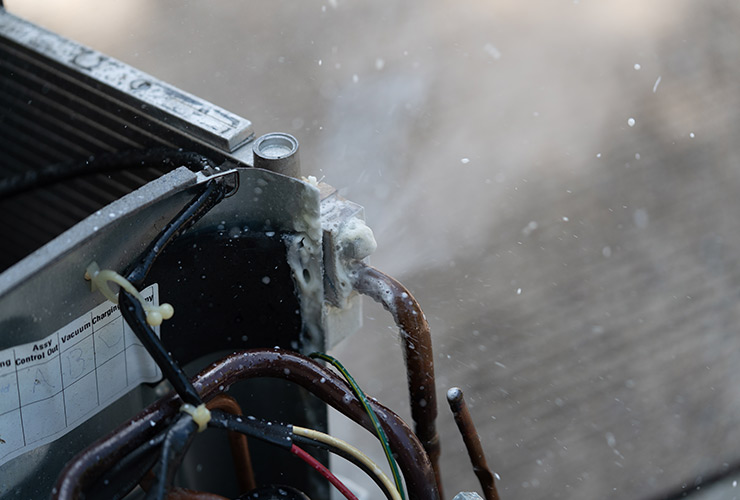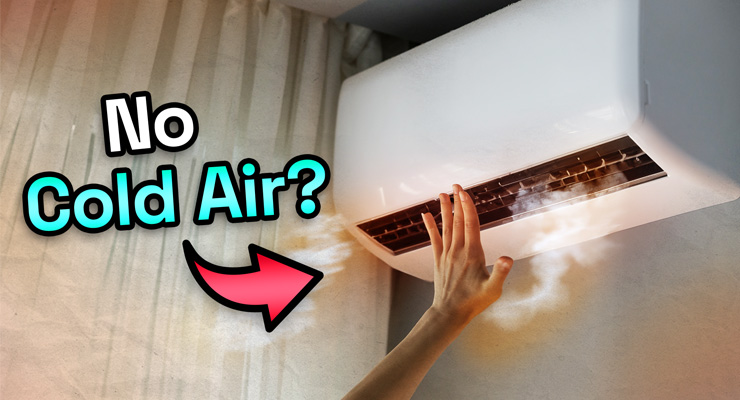Fast read
Several potential reasons why your air conditioner might not be blowing cool air range from simple issues like a dirty filter to more complex problems like refrigerant leaks or damaged components. Before contacting a professional, there are a few troubleshooting steps you can take.
Start by checking your air filter, as a dirty filter can obstruct airflow and cause your home to overheat. Additionally, inspect the outside condenser unit for blockages, such as dirt or debris, which can impede airflow and reduce cooling efficiency.
Other potential issues include a refrigerant leak, frozen evaporator coil, or undersized air conditioner. If you cannot resolve the problem on your own, it's advisable to contact a professional HVAC specialist for assistance in diagnosing and repairing the issue.
Troubleshooting Guide: Why Your Air Conditioner Isn’t Blowing Cold Air
There are several reasons why your air conditioner may not be blowing cold air. It could be a simple issue like a thermostat that needs adjusting or a dirty filter. It could also be a more complex problem that requires replacing a component.
Dirt in the air filter
Your air conditioner may have an air filter in or near the interior air handler unit. As airborne particles such as dust and dirt enter the air handler unit, the filter captures them. It keeps the system’s components cleaner and more efficient and can also keep the air in your house cleaner.
A clogged air filter can obstruct airflow and cause your house to overheat. It can even force the system to shut down altogether in severe circumstances.
If your thermostat is working properly but you still haven’t had cold air, look for your system’s air filter, switch it off, remove it, and clean it. If your central air conditioner still doesn’t chill your home after you’ve confirmed that your air filter is clean, you’ll need to check other system components or contact a professional.
Refrigerant leak
The chemical refrigerant is essential to the cooling process. The system changes liquid to gas as it moves through coils.
It removes heat and humidity from indoor air. Then, it releases it outside. A refrigerant leak can cause your AC system to operate for prolonged periods without sufficiently cooling your home, stop blowing cold air, or cause a damaged or failing compressor and complete system shutdown, depending on its severity.

The condenser unit has been blocked
As previously stated, your central air conditioning system includes an outside condenser unit. The condenser unit’s exterior contains a large exterior coil that wraps most of the way around the unit. The coil comprises a succession of thin metal “fins” that are extremely closely spaced.
A blocked or clogged condenser coil might cause your air con to work but not decrease temperatures inside. The condenser fan sucks air into the outside unit through the condenser coil to extract heat energy from your house while it’s working properly.
Dirt, grass, and other debris can clog the coil by accumulating between the fins. A dusty coil can result in lower energy efficiency, a shortage of cold air at the registers, or, in the worst-case scenario, a full system shutdown or compressor failure because of abuse. Clearing dirt, gently washing the coil or carefully vacuuming the coil with a brush attachment are all solutions for cleaning the coil. If your system is still not cooling, it’s time to call a professional.
Frozen evaporator coil
An evaporator coil is part of the interior component of your central air conditioning system. If your indoor unit is a furnace, the evaporator coil is located outside the furnace in its cabinet.
The evaporator coil is located within the fan coil cabinet if the indoor unit is a fan coil (usually as part of a heat pump system). Warm indoor air goes through the evaporator coil, which removes heat energy and humidity. The air is then cycled back into your house, making it cooler and more pleasant. The following are symptoms of a frozen evaporator coil:
- Insufficient cooling
- Condensate drainage near your indoor unit is excessive
- Increased utility bills
- Frost accumulates on outside refrigerant tubing or the outdoor unit in severe circumstances
- Frost is accumulating on the copper refrigerant tubing that leads to the coil cabinet
Since accessing the evaporator coil is tricky, leaving repairing difficulties with a frozen evaporator coil to an HVAC specialist is preferable.
Undersized air conditioner
Air conditioners are “sized” regarding the cooling they can offer in BTUh (British Thermal Units per hour). Under normal conditions, an undersized air conditioner may not cause any problems. However, when the temperature outside rises, your air conditioner may have to work more to keep you cool.
Although the rating information on the cabinet panel may help you calculate the size of your AC unit, it will be tough to tell whether it is the “appropriate size” for your home. Sizing a system for your house depends on various parameters, including building and insulation quality.
If your system is inadequate, you may be able to offer cooling in troubled places by installing a ductless unit. Alternatively, replacing the system with one that is the proper size may be preferable. Contacting a certified HVAC specialist who can precisely measure your property and its optimal cooling capacity is the best method to handle size concerns.
A damaged heat pump can stop air conditioners from blowing cold air
Your outside unit might be a heat pump in some circumstances. A heat pump resembles an air conditioner but has additional components that allow it to cool and heat your home. It acts similarly to an air conditioner’s condenser unit in cooling and is susceptible to the same problems – unclean, clogged coils, frozen coils, refrigerant leaks, compressor failures, etc.
Check the thermostat settings, the air filter, and the condenser unit for previously identified concerns if your heat pump system isn’t cooling. If everything appears in order, but you’re still hot inside, contact your local HVAC company.
